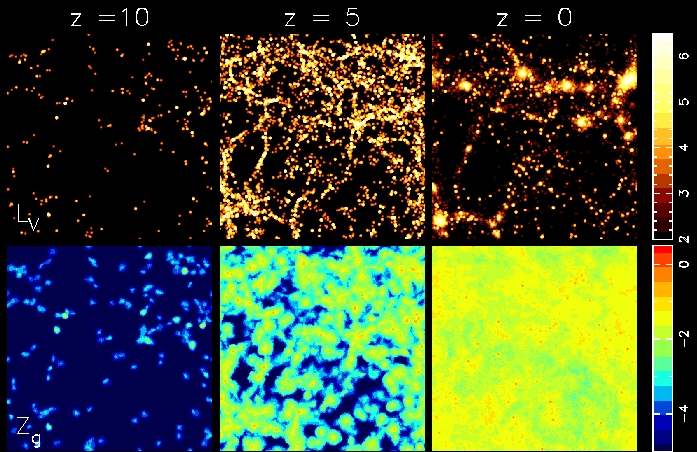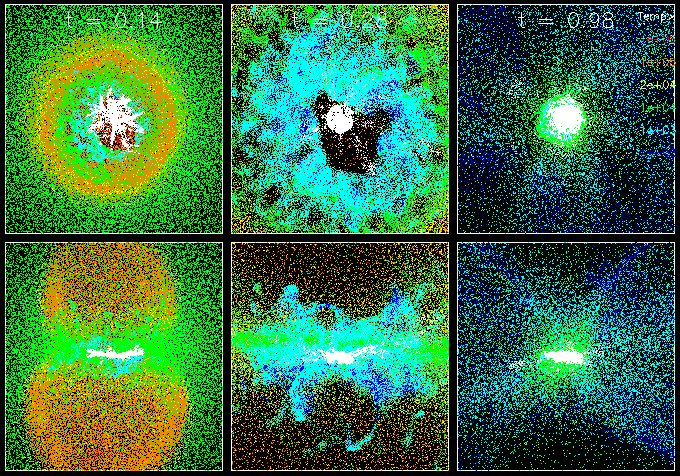Cosmological simulations
(Kobayashi)
Chemodynamical simulations
We are simulating the evolutionary history of the Universe across cosmic time using a self-consistent 3D hydrodynamical code (Kobayashi et al. 2007). This code is based on Gadget-3, where the Smoothed Particle Hydrodynamics (SPH) method is used to describe the hydrodynamics. We also include detailed physical processes undergone by atomic matter: namely, star formation, feedback from supernovae and active galactic nuclei (AGN; Taylor & Kobayashi 2014), and chemical enrichment from core-collapse and thermonuclear supernovae, and AGB stars (Kobayashi 2004; Kobayashi et al. 2011). These simulations are capable of comparison with observations of nearby and distant galaxies.
Cosmic chemical enrichment
Metallicities and elemental abundances are the fossils that can tell us the star formation history of the Universe. We have predicted the time/redshift evolution of the spatial distributions of elements, which are consistent with observations of star forming galaxies at high redshift (z~2) and early-type galaxies at low redshift (z~0). Chemical enrichment is dependent on the environment and - as is well known - metallicity varies even inside galaxies. These are respectively, the mass-metallicity relation, and the phenomenon of the metallicity radial gradient. This work aims to trace the physical origins of these observed relations.

The time evolution of our cosmological simulation in a periodic box 10/h Mpc on a side. We show the projected stellar V-luminosity (upper panels) and gas metallicity, log Z/Zsun (lower panels). Metals are ejected from stars into the intergalactic medium via supernova-driven galactic winds.
Supernova feedback
Supernovae eject not only thermal energy that serves to suppress star formation, but they also produce heavy elements to enhance star formation. Therefore, those processes have to be solved simultaneously. Supernova feedback, in particular hypernova feedback (Kobayashi et al. 2007), generates galactic winds from present-day less-massive galaxies and heavy elements are ejected from galaxies into the intergalactic medium. Supernova feedback plays an essential role in solving i) the angular momentum problem (Steinmetz & Navarro 1999), wherein the number and sizes of spiral galaxies in simulations are smaller than those observed, and ii) the missing satellite problem (Moore et al. 1999), in which the predicted number of satellite galaxies are much larger than those observed.

The time evolution of the formation of an isolated disk galaxy in a halo of mass of 10^10/h Msun. The black points represent star particles, while the gas particles are colour-coded according to their temperature. Each panel is 20 kpc on a side. The upper row shows face-on projections, the lower row gives edge-on views.
In massive galaxies, however, supernova feedback is inefficient (Kobayashi 2005). This is contrary to the observed 'down-sizing' phenomena (e.g., Cowie et al. 1996), where star formation takes place earlier and is terminated sooner in more massive galaxies.
AGN feedback
Feedback from active galactic nuclei (AGN) is an ideal mechanism as it works more effectively in massive galaxies (Croton et al. 2004). The importance of blackholes is underscored by the discovery of the blackhole mass-bulge mass relation (Magorrian et al. 1998). We have introduced a new model for seeding black holes motivated by the formation of the first stars in our cosmological simulations (Taylor & Kobayashi 2014), and showed better agreement with the observed down-sizing phenomena (Taylor & Kobayashi 2015a), and AGN-driven metal-enhanced outflows from massive galaxies (Taylor & Kobayashi 2015b).
The temperature evolution of the centre of the most massive galaxy (10^12/h Msun) in the 25/h Mpc simulation box. Red is for high temperature.
These touch on a big question of galactic astronomy, the origin of the galactic morphology. How did spiral and elliptical galaxies form?